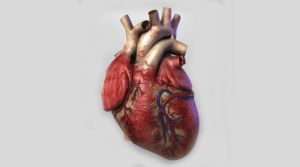 Once again research is finding effects on health from nanoparticles and air pollution - this time the heart. Tiny air pollution particles less than 100 nm (nanometers) in size are typically called "ultrafine particles", but actually they are so small that they are nanoparticles.
Once again research is finding effects on health from nanoparticles and air pollution - this time the heart. Tiny air pollution particles less than 100 nm (nanometers) in size are typically called "ultrafine particles", but actually they are so small that they are nanoparticles.
They are NOT regulated in the United States, even though many researchers feel that they are the most dangerous particles found in air pollution. This is because their small size means they are easily inhaled and then get into human lungs and organs, and even cells.
Where do they come from? They get into the air from industry (e.g. metal processing, power generation plants), from the exhaust of vehicles (from vehicle combustion), and from friction when using vehicle brakes.
The researchers write that the air in polluted urban areas and next to roads have a lot of these iron-rich nanoparticles from vehicle combustion and friction. And also that these particles are "strongly magnetic".
Earlier research in the urban Mexico City area found that these nanoparticles were found in the brains of all people, starting at young ages (they had died suddenly in accidents, which is why the brains could be analyzed). Keep in mind that Mexico City has high levels of air pollution, but so do many other urban areas throughout the world.
This latest study from a team of international researchers analyzed both the hearts of young people who died suddenly, as well as animals - and they compared the results from those exposed to high levels of urban air pollution (Mexico City metro area) and those from areas with low amounts of air pollution (the "controls"). The results were not good: all hearts from the Mexico City area (high air pollution) had lots of the same iron-rich magnetic nanoparticles ("in abundance") that are found in the air. Billions of nanoparticles in each heart, even in the youngest 3 year old child!
These nanoparticles are inhaled, then enter the person's circulatory system (carried by blood cells), and then into cardiac cells. As the researchers stated: the magnetic nanoparticles were "highly abundant in left ventricular samples from young subjects exposed to high concentrations of particulate air pollution above current US EPA standards. The organelles and structures containing abundant nanoparticles displayed substantial abnormality". Hearts from low pollution areas appeared normal.
This could explain why people living in polluted urban areas, including in the United States, have a greater risk for heart disease (cardiovascular disease), including heart attacks and strokes, as well as premature death. This research also highlights why we need to regulate these tiny particles in the air. As the researchers said: "This is a serious public health concern".
Excerpts from The Guardian: Billions of air pollution particles found in hearts of city dwellers ...continue reading "Pollution Nanoparticles Found In Human Hearts"
 There has been a debate for years over whether surgery plus traditional medical therapy (medications + lifestyle changes) is better than just medications and lifestyle changes for treating blocked arteries (ischemia) and preventing heart attacks and death. A recent study looked at this issue and found that there is no advantage to initially doing invasive procedures such as bypass surgery and stents for stable heart disease and moderately and severely blocked arteries. The surgical approach did not reduce the number of heart attacks and deaths. Sooo... it looks like medications and lifestyle changes alone may be the way to start treatment.
There has been a debate for years over whether surgery plus traditional medical therapy (medications + lifestyle changes) is better than just medications and lifestyle changes for treating blocked arteries (ischemia) and preventing heart attacks and death. A recent study looked at this issue and found that there is no advantage to initially doing invasive procedures such as bypass surgery and stents for stable heart disease and moderately and severely blocked arteries. The surgical approach did not reduce the number of heart attacks and deaths. Sooo... it looks like medications and lifestyle changes alone may be the way to start treatment.
 Another study finding that eating an egg each day is totally fine for our health. Of course it is! For years nutritionists were obsessed with the cholesterol in eggs, thinking it must translate into being bad for heart health. Remember the advice to only eat egg whites?
Another study finding that eating an egg each day is totally fine for our health. Of course it is! For years nutritionists were obsessed with the cholesterol in eggs, thinking it must translate into being bad for heart health. Remember the advice to only eat egg whites? Another great option for losing weight and better health may be to only eat within a 10 hour window, and then not eat for 14 hours (thus a nightly 14 hour fast). Many may find this easier than traditional dieting (counting calories and restricting eating). Just eat breakfast later, supper earlier, and no snacks in the evening. (But water is OK.)
Another great option for losing weight and better health may be to only eat within a 10 hour window, and then not eat for 14 hours (thus a nightly 14 hour fast). Many may find this easier than traditional dieting (counting calories and restricting eating). Just eat breakfast later, supper earlier, and no snacks in the evening. (But water is OK.) A new study has nicely illustrated how extreme air pollution gets quickly into a person and has negative health effects, but improvement occurs when the exposure to the air pollution ends.
A new study has nicely illustrated how extreme air pollution gets quickly into a person and has negative health effects, but improvement occurs when the exposure to the air pollution ends. Americans are eating so much ultra-processed food that it's now more than 50% of their daily calories. And why shouldn't they eat these foods? They're easy to get (fast foods, prepackaged foods, take out foods), they taste good, and they're great for people pressed for time. That's why they're called "convenience foods" and include fast foods, prepackaged foods, many frozen meals, take out foods, soda, packaged snacks, and many cakes, candies, and cookies.
Americans are eating so much ultra-processed food that it's now more than 50% of their daily calories. And why shouldn't they eat these foods? They're easy to get (fast foods, prepackaged foods, take out foods), they taste good, and they're great for people pressed for time. That's why they're called "convenience foods" and include fast foods, prepackaged foods, many frozen meals, take out foods, soda, packaged snacks, and many cakes, candies, and cookies. Are statins overprescribed? Currently many people without heart disease and at low risk of heart disease are taking them as a preventive, what is known as "primary prevention". Over the years, changes in medical guidelines have resulted in more and more lower risk older healthy people being prescribed statins. But there has been controversy over this: Are the statins really preventing heart disease and deaths in these low risk people? Also, do the benefits outweigh the harms (because all medications have side-effects, some more serious than others)? Finally, are the extra financial costs worth it?
Are statins overprescribed? Currently many people without heart disease and at low risk of heart disease are taking them as a preventive, what is known as "primary prevention". Over the years, changes in medical guidelines have resulted in more and more lower risk older healthy people being prescribed statins. But there has been controversy over this: Are the statins really preventing heart disease and deaths in these low risk people? Also, do the benefits outweigh the harms (because all medications have side-effects, some more serious than others)? Finally, are the extra financial costs worth it? A new
A new  Are we looking at vitamin D and sunlight the wrong way? Back in 2016 I
Are we looking at vitamin D and sunlight the wrong way? Back in 2016 I  The Paleo diet has been around for years and yet it continues to be controversial. The debate is whether following the Paleo diet long-term has health benefits or not? Supporters of the Paleo (Paleolothic) diet say it promotes gut health and is good for gut microbes, but
The Paleo diet has been around for years and yet it continues to be controversial. The debate is whether following the Paleo diet long-term has health benefits or not? Supporters of the Paleo (Paleolothic) diet say it promotes gut health and is good for gut microbes, but